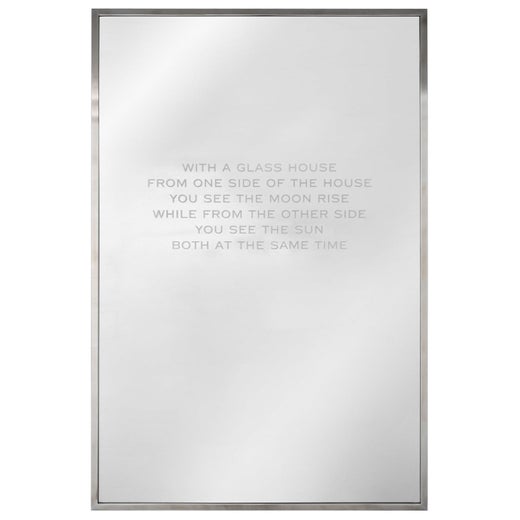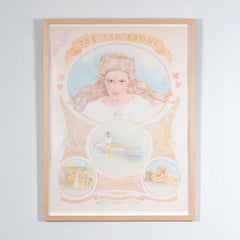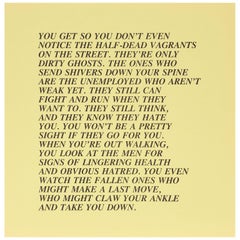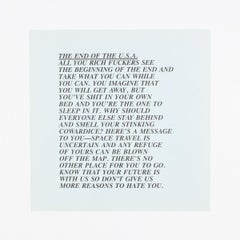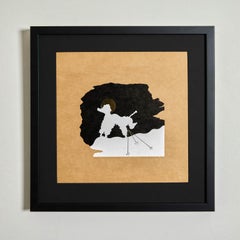Jenny HolzerRuin, "Inflammatory Essay" (from Documenta 1982)1982
1982
About the Item
- Creator:Jenny Holzer (1950, American)
- Creation Year:1982
- Dimensions:Height: 17 in (43.18 cm)Width: 17 in (43.18 cm)
- Medium:
- Movement & Style:
- Period:
- Condition:Very good condition Detailed condition report by request Note: Essays were photographed in plastic protective sleeves Literature: "Jenny Holzer" by Diane Waldman 1989, pg. 58-59.
- Gallery Location:Toronto, CA
- Reference Number:Seller: 10-201stDibs: LU21526939112
Jenny Holzer
Known for taking art out of the traditional “white cube” of galleries and museums and onto the streets, Jenny Holzer is one of the most potent feminist Neo-Conceptual artists of the 20th century. Her most iconic work critiques the information age and consumerism by reclaiming its primary media — conventional print billboards, storefront posters and LED signs.
“I used language because I wanted to offer content that people — not necessarily art people — could understand,” the Ohio-born Holzer told Interview magazine. She received her MFA in painting from Rhode Island School of Design, where her work was influenced by Abstract Expressionism. It was while in the Independent Study Program at the Whitney Museum of American Art that Holzer became inspired to work at the intersection of public art and language.
In the late 1970s, after becoming an active participant in the downtown Manhattan artist collective Colab, which included Tom Otterness and Christy Rupp, Holzer began to create her legendary “Truisms” series. Printing anonymous one-line aphorisms in bold and italicized text on broadsheets, she pasted them up in public spaces all over New York City. The “Truisms” are provocative in questioning how we receive and process information. The work elicits debate and represents a range of perspectives. In an era that saw the rise of street art and graffiti, Holzer’s pithy word art would also find viewers by way of T-shirts, stickers and park benches, into which her slogans were carved.
Holzer’s more combative “Inflammatory Essays” (1979–82) took the form of mass-produced posters on colored paper — each featuring paragraphs as compared to the punch-line structure of “Truisms.” These touched on subjects such as violence, misogyny, power structures and consumerism, all of which have continued to be central in her work.
Starting in 1982 as part of a Public Art Fund project, Holzer projected “Protect me from what I want” and other “Truisms” on the Spectacolor board, a large computerized light signboard in New York City’s Times Square. Her “Abuse of power comes as no surprise,” which has appeared on T-shirts as part of the series, has taken on new life in an increasingly politically divided America.
Just as it did in the 1970s, the forcefulness of her work continues to make both viewers and the art world stop and pay attention. She has had solo exhibitions at the Brooklyn Museum, the Solomon R. Guggenheim Museum, the Tate Modern in London and elsewhere. She has also created permanent installations including the New York City AIDS Memorial. A 2014 show at New York’s Cheim & Read featured oil-on-linen canvases based on declassified government files pertaining to detainees from the Iraq and Afghanistan wars.
Find Jenny Holzer prints and sculptures on 1stDibs.
You May Also Like
1990s Conceptual Abstract Prints
Offset, Lithograph
2010s Conceptual Abstract Prints
Lithograph, Offset
1960s Conceptual Abstract Prints
Offset, Lithograph
Early 2000s Conceptual Interior Prints
Lithograph, Offset
Early 2000s Conceptual Abstract Prints
Paper, Ink, Mixed Media, Lithograph, Offset
1980s Conceptual Abstract Prints
Offset, Permanent Marker, Lithograph
2010s Conceptual Abstract Prints
Offset, Lithograph
1970s Conceptual Animal Prints
Lithograph, Offset
1990s Conceptual Figurative Prints
Board, Lithograph, Offset
1980s Conceptual Figurative Prints
Ink, Lithograph, Offset
More From This Seller
View All1970s Conceptual Prints and Multiples
Lithograph, Offset
1980s Conceptual Prints and Multiples
Lithograph, Offset
1980s Conceptual More Prints
Offset
1980s Conceptual Prints and Multiples
Gold
1980s Conceptual Animal Prints
Lithograph, Screen
1990s Conceptual Prints and Multiples
Screen
